Introduction
This bulletin provides information on volumes and sentence outcomes for adult offenders (aged 18 or over at the time of conviction) sentenced for offences covered by the Sentencing Council’s draft guidelines on immigration offences.
There are six draft guidelines covering the following offences:
- Assisting unlawful immigration to the UK, Immigration Act 1971 (section 25)
- Helping asylum-seekers to enter the UK, Immigration Act 1971 (section 25A)
- Deception, Immigration Act 1971 (section 24A)
- Possessing false identity documents etc with improper intention, Identity Documents Act 2010 (section 4)
- Possessing false identity documents etc without reasonable excuse, Identity Documents Act 2010 (section 6)
- Breaching a deportation order, Immigration Act 1971 (section 24(A1))
- Knowingly entering the UK without leave, Immigration Act 1971 (section 24(B1))
- Knowingly arriving in the UK without valid entry clearance, Immigration Act 1971 (section 24(D1))
There are no existing guidelines for these offences. Separate draft guidelines are proposed for the offences of deception, possessing false identity documents etc with improper intention, possessing false identity documents etc without reasonable excuse and breaching a deportation order. However, a single draft guideline is proposed to cover the offences of assisting unlawful immigration to the UK and helping asylum-seekers to enter the UK. There is also one draft guideline covering the offences of knowingly entering the UK without leave and knowingly arriving in the UK without valid entry clearance. The statistics are provided separately for each of these offences in this bulletin.
The offences of breaching a deportation order, knowingly entering the UK without leave and knowingly arriving in the UK without valid entry clearance came into force in June 2022 under the Nationality and Borders Act (NABA). Therefore, the data presented for these offences only cover the period June to December 2022.
The Court Proceedings Database (CPD), maintained by the Ministry of Justice, is the data source for this bulletin. For more information on this data source please see the ‘Further information’ section at the end of this document.
Additional figures for this offence, including breakdowns by demographic groups (sex, age group and ethnicity), can be found in the data tables which are available to download as Open Document spreadsheets on the Sentencing Council: Publications webpage.
Assisting unlawful immigration to the UK
Sentence volumes
The number of offenders sentenced for assisting unlawful immigration to the UK has generally declined since 2016 when the volume was around 260 (see Figure 1). In 2022, around 100 offenders were sentenced for this offence, and all of these were sentenced in the Crown Court.
Figure 1: Number of adult offenders sentenced for assisting unlawful immigration to the UK, 2012 to 2022
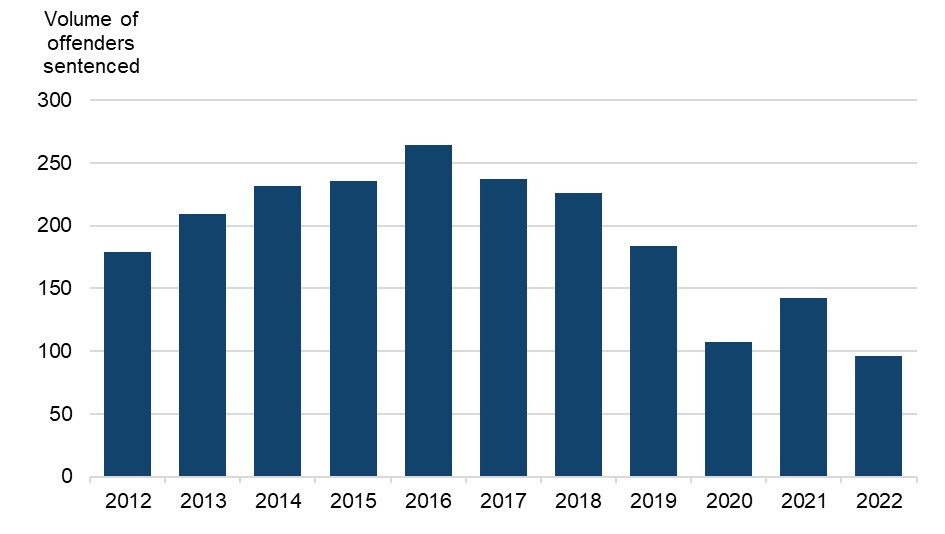
Sentence outcomes
The majority of offenders are consistently sentenced to immediate custody for this offence. In 2022, around 84 per cent of offenders received immediate custody. A further 15 per cent received a suspended sentence and the remaining 1 per cent were ‘Otherwise dealt with’ (see the ‘Further information’ section for more details).
Sentence lengths
The statutory maximum sentence for this offence increased to life imprisonment in June 2022; prior to this, the statutory maximum sentence was 14 years’ custody. For those sentenced to immediate custody in 2022, the (mean) average custodial sentence length (ACSL) after any reduction for guilty plea was 3 years 1 month. All offenders received a sentence of 8 years or less in 2022, after any reduction for guilty plea.
Helping asylum-seekers to enter the UK
Sentence volumes
The offence of helping asylum-seekers to enter the UK is very low volume. In 2022, fewer than 5 offenders were sentenced (see Figure 2).
Figure 2: Number of adult offenders sentenced for helping asylum-seekers to enter the UK, 2012 to 2022
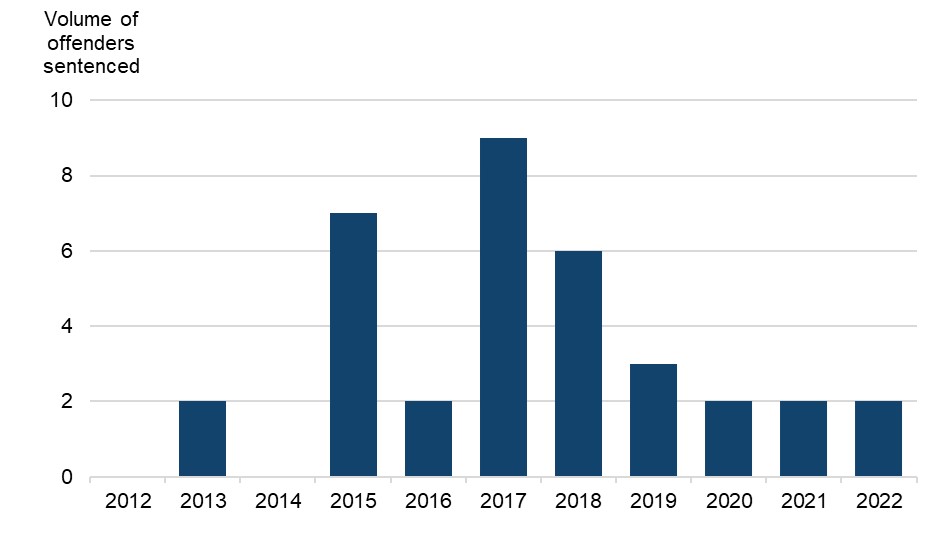
Sentence outcomes
In the last four years, all offenders received an immediate custodial sentence.
Sentence lengths
The statutory maximum sentence for this offence increased to life imprisonment in June 2022; prior to this, the statutory maximum sentence was 14 years’ custody. Due to the small number of offenders sentenced for this offence each year, the ACSL has been provided for the last five years combined. Between 2018 and 2022, the ACSL was 3 years 11 months. In the last 11 years, all offenders sentenced to immediate custody received a sentence of 8 years or less, after any reduction for guilty plea.
Deception
Sentence volumes
Deception is a very low volume offence, with around 10 offenders sentenced in 2022. There has been a general decline since 2012 when around 60 offenders were sentenced. The majority of offenders are sentenced at the Crown Court (78 per cent in 2022).
Figure 3: Number of adult offenders sentenced for deception, 2012 to 2022
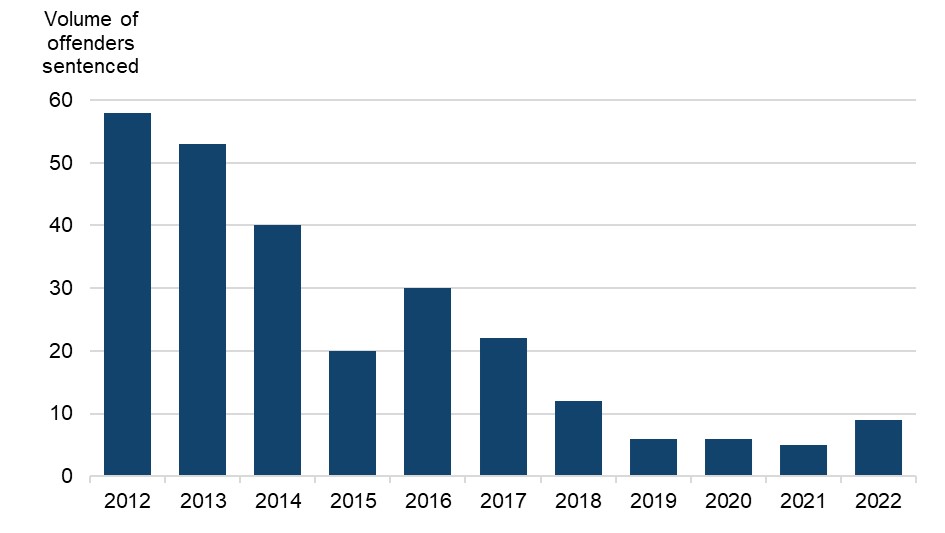
Sentence outcomes
Immediate custody was consistently the most common sentence outcome during the last 11 years. In 2022, around 89 per cent of offenders were sentenced to immediate custody and the remaining 11 per cent received a suspended sentence.
Sentence lengths
The statutory maximum sentence for this offence is 2 years’ custody. Due to the small number of offenders sentenced each year, the ACSL has been calculated for the last five years combined. During the period 2018 to 2022, the ACSL was 11 months and all offenders received a sentence of 18 months or less, after any reduction for guilty plea.
Possessing false identity documents etc with improper intention
Sentence volumes
The volume of offenders sentenced for possessing false identity documents etc with improper intention has decreased since 2013. In 2022, around 190 offenders were sentenced, compared to around 860 in 2013. This is an indictable only offence and can only be sentenced in the Crown Court.
Figure 4: Number of adult offenders sentenced for possessing false identity documents etc with improper intention, 2012 to 2022
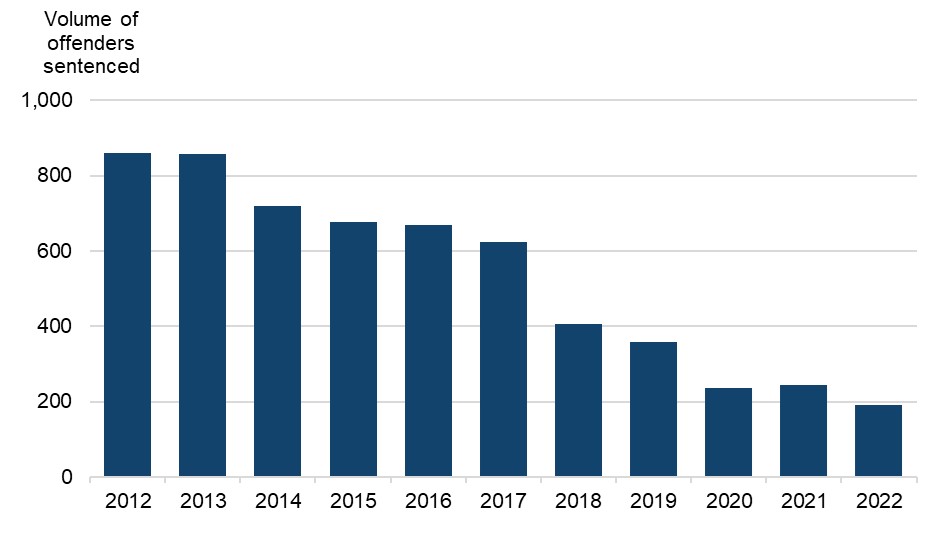
Sentence outcomes
Immediate custody has consistently been the most common sentence outcome across the period 2012 to 2022. In 2022, around 72 per cent of offenders were sentenced to immediate custody. A further 20 per cent received a suspended sentence and around 6 per cent received a community sentence. The remaining offenders were ‘Otherwise dealt with’ (1 per cent), received a fine (1 per cent) or a discharge (1 per cent).
Sentence lengths
The statutory maximum sentence for this offence is 10 years’ custody. In 2022, the ACSL was 9 months after any reduction for guilty plea and this is similar to previous years. The majority of offenders receive a sentence of 1 year or less (84 per cent of immediate custodial sentences were 1 year or less in 2022).
Possessing false identity documents etc without reasonable excuse
Sentence volumes
The volume of offenders sentenced for possessing false identity documents etc without reasonable excuse has declined since 2012, with the last 4 years being relatively stable. In 2022, around 70 offenders were sentenced compared to 240 in 2012. Nearly two-thirds of offenders (62 per cent) were sentenced in the magistrates’ courts in 2022.
Figure 5: Number of adult offenders sentenced for possessing false identity documents etc without reasonable excuse, 2012 to 2022
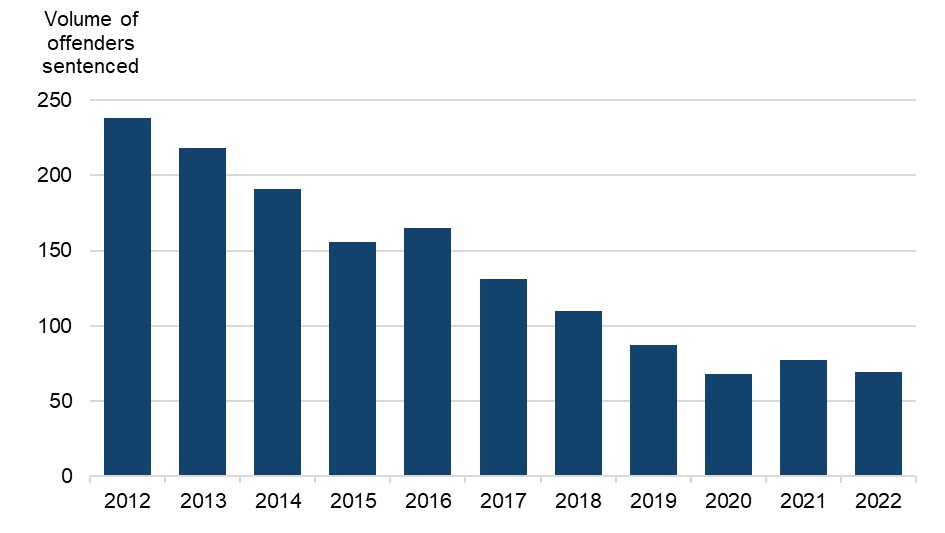
Sentence outcomes
The most common sentence outcomes in 2022 were immediate custody (26 per cent of offenders) and fines (25 per cent). Around 20 per cent received a community sentence and a further 20 per cent received a suspended sentence. The remaining offenders received a discharge (4 per cent) or were ‘Otherwise dealt with’ (4 per cent).
Sentence lengths
The statutory maximum sentence for this offence is 2 years’ custody. Of those who received immediate custody, the ACSL in 2022 was 4 months and all offenders received a sentence of 12 months or less, after any reduction for guilty plea.
Breaching a deportation order
Sentence volumes
The offence of breaching a deportation order came into force in June 2022. Around 20 offenders were sentenced from June to December 2022 and the majority of offenders were sentenced in the magistrates’ courts (70 per cent).
Sentence outcomes
Nearly all offenders received an immediate custodial sentence (91 per cent). The remaining offenders received a suspended sentence (4 per cent) or were ‘Otherwise dealt with’ (4 per cent).
Sentence lengths
Between June and December 2022, the ACSL was 7 months. All offenders who received immediate custody were sentenced to 2 years or less, after any reduction for guilty plea. The statutory maximum sentence for this offence is 5 years’ custody.
Knowingly entering the UK without leave
Sentence volumes
The offence of knowingly entering the UK without leave came into force in June 2022. Between June and December 2022, fewer than 5 offenders were sentenced.
Sentence outcomes
All offenders received a custodial sentence (75 per cent were immediate and 25 per cent were suspended).
Sentence lengths
As fewer than 5 offenders were sentenced to immediate custody from June to December 2022, the ACSL has not been provided. The statutory maximum sentence for this offence is 4 years’ custody. All offenders who received immediate custody were given a sentence greater than 6 months and up to and including 12 months, after any reduction for guilty plea.
Knowingly arriving in the UK without valid entry clearance
Sentence volumes
The offence of knowingly arriving in the UK without valid entry clearance came into force in June 2022. Around 120 offenders were sentenced between June and December 2022. The majority of offenders were sentenced in the magistrates’ courts (91 per cent).
Sentence outcomes
All offenders received a custodial sentence; around 89 per cent were immediate and 11 per cent were suspended.
Sentence lengths
The statutory maximum sentence for this offence is 4 years’ custody. The ACSL during the period June to December 2022 was 8 months. Almost all offenders received a sentence of 12 months or less (97 per cent), after any reduction for guilty plea.
Further information
Volumes of sentences
The data presented in this bulletin only include cases where the offence detailed was the principal offence committed. When an offender has been found guilty of two or more offences, the principal offence is the offence for which the heaviest penalty is imposed. Where the same disposal is imposed for two or more offences, the offence selected is the offence for which the statutory maximum penalty is the most severe. Although the offender will receive a sentence for each of the offences that they are convicted of, it is only the sentence for the principal offence that is presented in this bulletin.
Sentence outcomes
The outcomes presented are the final sentence outcomes, after taking into account all factors of the case, including whether a guilty plea was made. This is because the sentence length information available in the Court Proceedings Database (CPD) is the final sentence imposed, after any reduction for guilty plea. Sentence outcomes presented in this bulletin are therefore not directly comparable to outcomes in the sentencing guideline tables, which instead show starting point sentences before a guilty plea has been entered.
General conventions
Actual numbers of sentences have been rounded to the nearest 100, when more than 1,000 offenders were sentenced, and to the nearest 10 when fewer than 1,000 offenders were sentenced.
Proportions of sentencing outcomes have been rounded to the nearest integer. Percentages in this report may not appear to sum to 100 per cent, due to rounding.
Data sources and quality
The CPD, maintained by the Ministry of Justice (MoJ), is the data source for these statistics. Every effort is made by MoJ and the Sentencing Council to ensure that the figures presented in this publication are accurate and complete. However, it is important to note that these data have been extracted from large administrative data systems generated by the courts and police forces. As a consequence, care should be taken to ensure data collection processes and their inevitable limitations are taken into account when those data are used.
Further details of the processes by which MoJ validate the records in the CPD can be found inside the ‘Technical Guide to Criminal Justice Statistics’ within the Criminal Justice System Statistics Quarterly (CJSQ) publication.
The data in this report align with figures published in the Criminal Justice System statistics quarterly: December 2022 publication (CJSQ) which was originally published in May 2023. Since then, the CJSQ publication has been revised to reflect changes to the underlying data, which have not been reflected in these statistics. As such, the latest MoJ published statistics will not match the statistics in this report. Further information on changes to MoJ’s data processing can be found in the changes and revisions section of the latest publication.
The average custodial sentence lengths (ACSLs) presented in this statistical bulletin are mean average custodial sentence length values for offenders sentenced to determinate custodial sentences, after any reduction for guilty plea.
‘Otherwise dealt with’ covers miscellaneous disposals. Please note that due to a data issue currently under investigation, there are a number of cases which are incorrectly categorised in the CPD as ‘Otherwise dealt with’. Therefore, these volumes and proportions should be treated with caution.
Figures presented include the time period from March 2020 in which restrictions were initially placed on the criminal justice system due to the coronavirus (COVID-19) pandemic, and the ongoing courts’ recovery since. It is therefore possible that these figures may reflect the impact of the pandemic on court processes and prioritisation and the subsequent recovery, rather than a continuation of the longer-term series, so care should be taken when interpreting these figures.
Contact points for further information
We would be very pleased to hear your views on our statistical bulletins. If you have any feedback or comments, please send them to: research@sentencingcouncil.gov.uk
Responsible Statistician: Sharmi Nath
Press Office enquiries: Kathryn Montague Tel: 020 7071 5792
Further information on the Sentencing Council and its work can be found on the Sentencing Council webpage.